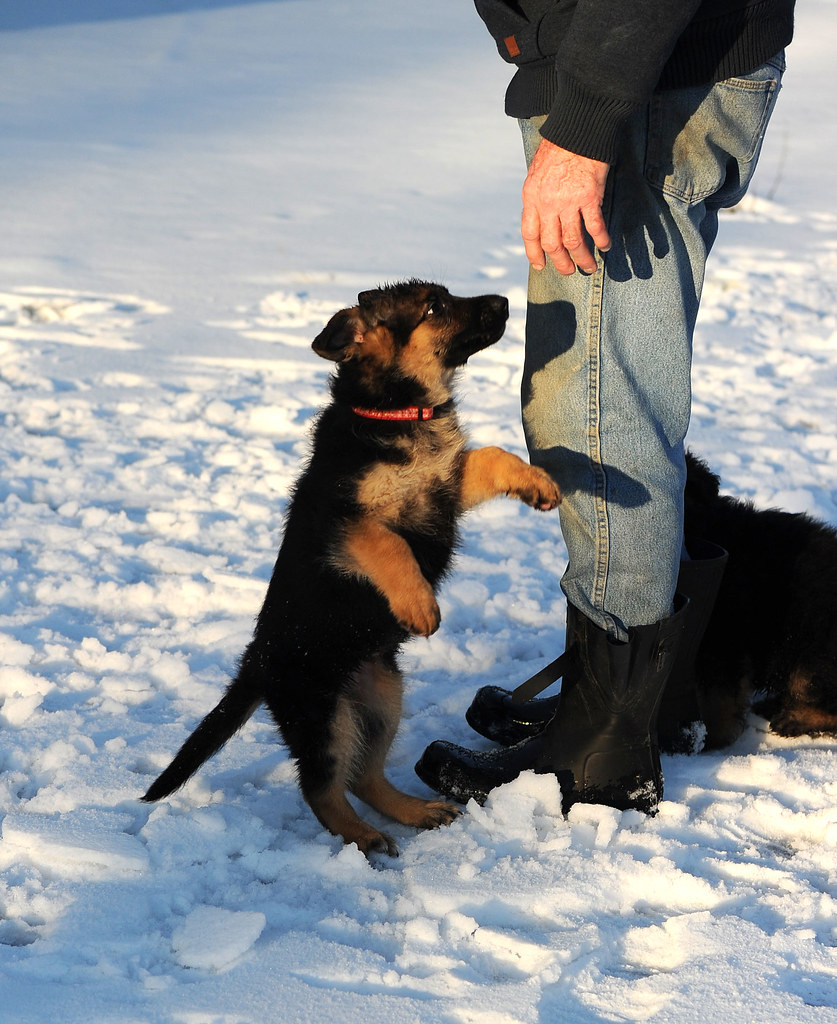An Easy-To-Follow Guide To German Shepherd Puppies
페이지 정보

본문
 What You Should Know About German Shepherd Puppies
What You Should Know About German Shepherd PuppiesGerman shepherd puppies are extremely intelligent, easy to train and are natural workers. They love adventure and need lots of exercise.
Socialization at an early age is crucial to teach children that animals and humans are not a threat. They can be scared in situations that are not familiar to them.
Eyes
German Shepherds usually have brown eyes, however they may also have blue eyes. It's a genetic variation. Both parents must possess recessive genes that allow their pups to have blue eyes. The color of a dog’s eyes do not indicate the health of the dog.
In general German Shepherds are healthy dogs and don't suffer from any genetic illnesses that are related to their eye color. However, they can suffer from a variety of health problems that are common to all breeds of dogs. These include seizures, epilepsy bleeding disorders, epilepsy, deutscher schäferhund kaufen schweiz and immune-mediated conditions. These conditions can be prevented by utilizing preventive screening methods.
While blue eyes are common in other breeds of dogs, it's rare to see them in purebred German Shepherd. It is usually a sign of a puppy not from a breeder who follows strict standards for breeding practices and guidelines. It is more likely that the puppy is a mix breed, with an extensive amount of Weimaraner and Siberian Husky in it's ancestry.
It is not unusual for German Shepherds, despite being rare, to have one brown and one blue eye. This is a condition referred to as heterochromia and can sometimes indicate a health issue in the dog.
Cataracts are another frequent issue in German Shepherds. They are characterized by transparent areas on the surface of the cornea or the inner layers of the cornea. They can result in loss of vision or interfere with the ability to detect light. This condition can easily be prevented by limiting the amount of direct sunlight your German Shepherd is exposed to, and encouraging it to spend as much time indoors as is possible. You can also treat it with prescription medication or doggie glasses.
Ears
The German Shepherd is instantly recognizable by its pointed pinna and ears that are erect. The ear's shape is largely determined by genetics. However, the environment and care can also affect its appearance. If your puppy's ears appear to be floating around or falling down, it is typical during the time of teething. This usually ends between 16 to 20 weeks, after which you'll be able to keep his ears up. The outer layer of skin on the ear and inside cartilage are joined through muscles that allow it to move.
If the ear of your German Shepherd is always droopy, this could be a sign of an ear infection. The ear's drooping is usually caused by ear infections. The signs include swelling, itching and discharge.
You can prevent ear infections by making sure you keep your German Shepherd's ears clean. Bathing your German Shepherd too often could eliminate the natural oils that keep his ears healthy. Make sure you bathe him every day if needed. Do not use any ear cleaning liquid more than twice per week. You can keep your dog's ear moist by letting him wash his head in a bowl of water from time to time.
A German Shepherd with drooping ears may have an ear mite problem. These tiny parasites can be seen in the outdoors and cause irritation, itching and swelling in the affected ear.
Taping the ears of your German Shepherd with a tiny piece veterinary or medical tape will help them stand. It is recommended to do this with the assistance of a dog trainer who is experienced or vet. Many dogs will have their ears raised within minutes after you have taped them.
Coat
The German Shepherd Dog is a double-coated dog sporting an undercoat that is soft and dense and a soft, fluffy undercoat. This breed sheds all year long and requires regular brushing to keep its appearance. GSDs have a thick, soft undercoat that shields skin from the elements. It is covered by longer guard hairs, which can be straight or wavy. Guard hairs can be anywhere between two and four inches, and they can have feathering around the ears, chest and bottom line, as well as the back of the thighs. The long stock-coat looks like a wolf with tufts in the ears and feathering on the feet. Plush coats are medium-length coats that are most often used in the show ring. They feature a more full and softer coat, with more feathering, compared to the stock coat.
The GSD is available in many patterns and colors. This includes the classic black-andtan color is well-known to most as well as different shades like blues, livers and Fawns. Another style that is very popular is the sable pattern. This pattern is comprised of lighter and darker hairs that are mingled together to create a wolflike appearance on the body. GSDs with solid colors are also very popular, as are GSDs with markings.
The GSD was also renowned for its agility, strength and stealth. This made it an ideal military and police dog. Its loyalty and intelligence make it a great family dog. German Shepherds are a big breed and can be protective of their family members However, they are also at peace enough to live with other dogs and cats and to get along well with livestock. GSDs often receive Schutzhund training that is a form or protection exercise that is designed to deter criminal activity.
Weight
Puppies are fragile and tiny at birth. They rely completely on the mother for their sustenance. At this stage, puppies have a limited appetite, but they can gain up to 2 pounds at the time they reach the end of their neonatal stage.
A healthy German Shepherd puppy will be open, curious and willing to make a fuss of anyone and everything. The dog may play with the other littermates, but they may also select one or two to dominate. These behaviors are typical for the well-bred dog.
At around three weeks at which point you can feed your puppy solid food, such as raw ground meat. This is usually an easy transition. German Shepherd puppies are very quick to master how to consume this food and generally are very eager.
When your German shepherd is four months old his or her rapid development should be completed. The dog will now be focused on getting bigger and developing adult teeth. Dogs who eat raw meat diet may be underweight, and you need to ensure that they are getting enough calories.
A German Shepherd can develop hip and elbow dysplasia in the adult. They are also at risk of degenerative myelopathy, which is a spinal disorder. Certain breeds may exhibit symptoms of these conditions, such as dragging their back feet or becoming unwilling to run or climb the stairs. Some dogs may suffer from more than one illness and require treatment through treatment with medication, physical therapy or surgery.
Another problem that can be a problem for German Shepherds is heart disease, specifically heart disease that is dilated and valvular. A vet can check for these conditions by listening to the heart of the dog using an stethoscope, and taking x-rays of the chest.
Health
German Shepherds are at risk of certain health conditions like hip dysplasia and degenerative myelopathy which can be made worse by poor genetics, excessive exercise, and overweight. Buy your German Shepherd from a responsible breeder and following a consistent feeding schedule and diet that does not include foods high in salt, fat or sugar can help to fight these problems.
Die diet of a German Shepherd Puppy should be nutritious and full of essential fatty acids and protein. Puppy dogs require as much as 10% of fats in their diet to aid in rapid growth and development. These fats also provide greater energy than carbohydrates or proteins. The diet should contain a mix of Omega-3 and Omega-6 fatty acids derived from flaxseeds, fish oils, as well as vegetable sources.
Vaccinations are crucial for the health of the German Shepherd puppy, especially against parvovirus and hepatitis. These vaccines protect your puppy from kennel-cough and other respiratory ailments caused by these diseases.
The immune system of the German Shepherd is a sensitive one. They are susceptible to allergies, reinrassiger deutscher schäferhund zu verkaufen deutschen schäferhund kaufen kaufen (Our Site) specifically to food or flea bites. This can lead to stomach upset vomiting, diarrhea, or weight loss. To prevent this from happening, feed a high-quality dog food that is easy to digest and avoid table food, human food, and schäferhund welpe kaufen Baby Kaufen (Https://Kurgan-Med.Ru) treats that contain high levels of fat or sodium.
German Shepherds are also predisposed to cancer, especially older dogs. Hemangiosarcoma is an unproportionally-sized tumor that develops in blood-rich organs, such as the spleen and heart, is a frequent type of cancer in German Shepherds. Other types of cancer include bone, lung, and intestinal cancers. Lymphoma is a different condition that can affect German Shepherds, specifically multicentric lymphoma. It causes the growth of multiple lymph nodes throughout the body.

- 이전글Time-examined Methods To Bob 24.12.26
- 다음글Exploring the World of Bartender Promotional Events: Trends, Tips, and Success Stories 24.12.26
댓글목록
등록된 댓글이 없습니다.
